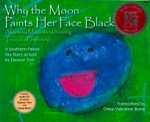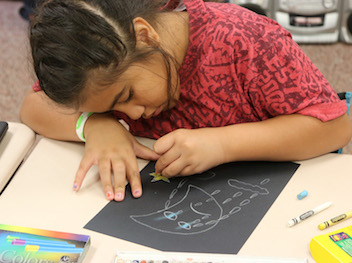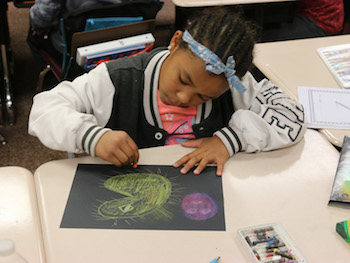SUBJECTS
GRADE
Show Results
Why the Moon Paints Her Face Black

Lesson Summary
- Listen and respond to a Paiute story.
- Explore art making, using chalk or crayons.
- Create a project depicting one of the scenes in the book.
Lesson Plan and Procedure
Lesson Key Facts
- Grade(s): 2, 3, 4, 5, 6
- Subject(s): English Language Arts, Social Studies, Visual Arts, Native American, Tribe Approved
- Duration of lesson: 45 minutes
- Author(s): Brenda Beyal and Chris Roberts

The Paiute Indian Tribe of Utah’s Tribal Council selected this lesson content in answer to the question, “What would you like the students of Utah to know about you?” Dorena Martineau, the Paiute Cultural Resource Director, represented the Paiute Indian Tribe of Utah in crafting the lesson to provide expertise, accuracy, and authenticity. The lesson was then approved by the Paiute Indian Tribe of Utah’s Tribal Council.
Before teaching this lesson, please explain to your students that there are many Indigenous tribes in the United States and that this lesson specifically focuses on the five bands of the Paiute Indian Tribe of Utah and does not represent other Native American groups. It is the hope of the Paiute Indian Tribe of Utah that other Native tribes will respect their choice to share these aspects of their history and culture.
Background
Storytelling has been and continues to be a powerful tool used by Native American tribes to pass down cultural values, beliefs, and traditions. The winter season for many tribes is the time to gather and tell stories. The stories are passed down from one generation to the next and binds the members of the tribe together. Most stories teach a lesson or explain how things came to be. Entertaining your audience while sharing stories is a key element to this oral tradition. The Paiute Indian Tribe of Utah is pleased to share this book with the children of Utah. It is their hope that the book will be used to open doors to studying the ways of the Paiute and also to study the wonders of the sky.
Introduction
Hand out a blank piece of black construction paper. Put crayons and chalk pastels out for students to share.

Introduce the book Why the Moon Paints Her Face Black to the students.
Teacher: We are going to read a Paiute tale transcribed by an author. Transcribe means to write thoughts, stories, and speech in printed form. The author, Chloe Valentine Brent, listened to Eleanor Tom, a Paiute elder, tell a story her grandmothers used to tell her. Ms. Brent wrote the story down, working hard to write with all the imagery that the story generates when told aloud.

Teacher: As I read the story, close your eyes and listen carefully. Pay attention to the images that come to your mind as I read. You will be given an opportunity to put the images down on paper after our reading.
Create
Read the story while the students listen with their eyes closed. After the reading, instruct the students to recreate the images that came to their minds. They can concentrate on one particular image or share several images on the paper. Give students time to work on their art. Listen to the story on CD told in Paiute by Eleanor Tom.
Encourage the students to explore ways to enhance their art.

Crayon
- Layering your crayons on top of one another creates more depth to your art. Begin with a lighter undertone, and layer darker colors on top.
- Crayons will resist one another if too many layers are put down.
- Because of the wax content, crayons are an excellent medium for scratching and etching out lines and details.
- Using a white crayon to outline lightly can help you organize and compose your art making.

Chalk pastel
- Blend chalk pastels by laying down colors next to each other. Use your finger, a tissue, or a Q-tip to blend.
- Use the side of the chalk to cover large areas, and use the point for details.
- Putting down dark pastels first will give rich, dark values. Using light before dark can muddy your art.
- Use hairspray as a fixative to keep the chalk from smearing.
Present
When students have completed their artwork, reread the story. As you read each page, ask the students to share their art at the point it relates to the story. If a page is not represented by anyone in the class, show the illustration in the book. Have students hang their art up in the same sequence used in the story.
Respond
Hold an impromptu silent art walk where students silently view the art created. Encourage students to analyze components of the art, interpret meaning, and reflect on their response to the art. Hold a short discussion about the art.
Connect
This story can be used as a springboard into deeper learning of science core subjects such as these:
- Introducing second graders to the processes of observing, recording, and recognizing objects and patterns in the night sky.
- Guiding third graders’ learning about the spherical shape of the moon and earth, and about how the rotation of the earth on its axis makes the sun and moon appear as if they are moving through the sky.
- Developing sixth graders’ working understanding of the cyclic patterns of lunar phases, eclipses of the sun and moon, and seasons.
The lesson can also be used to start or continue your classroom dialogue about how stories can contribute to bridge building between diverse cultures.
- Ask students to relate what stories are handed down in their families. Compare and contrast the stories with this Paiute story.
- Write a story together as a class that explains a natural phenomenon.
- Seek out other Native American stories to share with students.
Learning Objectives
- Create and present art that conveys meaning of a Paiute tale.
- Listen to a story and make connections using visual presentations.
- Explore the cultural traditions of storytelling.
Utah State Board of Education Standards
This lesson can be used to meet standards in many grades and subject areas. We will highlight one grade’s standards to give an example of application.
Grade 4 Visual Arts
- Strand CREATE (4.V.CR.): Students will generate artistic work by conceptualizing, organizing, and completing their artistic ideas. They will refine original work through persistence, reflection, and evaluation (Standards 4.V.CR.1-4).
- Strand PRESENT (4.V.P.) Students will analyze, interpret, refine, and select artistic work for presentation. They will convey meaning in the manner in which the art is presented (Standards 4.V.P.1-3).
- Standard 4.V.R.2: Analyze components in visual imagery that convey messages.
- Standard 4.V.CO.1: Create works of art that reflect community cultural traditions.
Grade 4 English Language Arts
- Standard 4.SL.2: Clearly summarize information presented in various formats and media and explain how the information pertains to the topic.
- Standard 4.SL.3: Use age-appropriate language, grammar, volume, and clear pronunciation when speaking or presenting.
a. Include visual displays and/or media, when appropriate, to convey information, elaborate, and enhance engagement of presentations. - Standard 4.R.12: Compare a visual or oral presentation of a story or drama with the text itself and identify where each version reflects specific descriptions and directions in the text. (RL) Interpret information presented visually, orally, or quantitatively and explain how the information contributes to an understanding of the text in which it appears. (RI)
Grade 4 Social Studies
- Standard 4.5.1: Describe sovereignty as it relates to Native American sovereign nations (Ute Mountain Ute Tribe, Ute Indian Tribe of the Uintah and Ouray reservation, Paiute Indian Tribe of Utah, San Juan Southern Paiute Tribe, Navajo (Diné) Nation, Northwestern Band of the Shoshone Nation, Confederated Tribes of Goshute, Skull Valley Band of Goshute) existing within Utah, and explain efforts to preserve and maintain their culture.
Equipment and Materials Needed
- Black construction paper (9x12)
- Crayons for each student
- Chalk pastels for students to share
- Book: Tom, Eleanor. Why the Moon Paints Her Face Black = Axanixay Maasahoych-Oong Tooqara Paruh-Xing: a Southern Paiute Sky Story. Torrey, UT: Capitol Reef Natural History Association, 2013.
Additional Resources
This lesson was created thanks to a grant from the National Endowment for the Arts and the Utah Division of Arts & Museums.
- Official website of the Paiute Tribe of Utah: http://www.utahpaiutes.org/.
This is a powerful opinion piece written by Joseph Bruchac on the relevancy of oral storytelling in indigenous cultures: https://www.theguardian.com/commentisfree/2010/jul/29/lasting-power-oral-tradition.
- Chloe Valentine Brent’s story on writing the book: http://www.usu.edu/today/index.cfm?id=52581.
- The First Time I Worked With Chalk Pastels, I absolutely Fell in Love: https://www.theartofed.com/podcasts/foolproof-strategies-teaching-chalk-pastels-ep-016/.
Image References
Image 1: James Hutson.
Image 2: Paiute Tribe of Utah.
Image 3: Capitol Reef Natural History Association.
Images 4–7: James Hutson.
© Brigham Young University and Paiute Indian Tribe of Utah

www.education.byu.edu/arts/lessons
 Download
Download